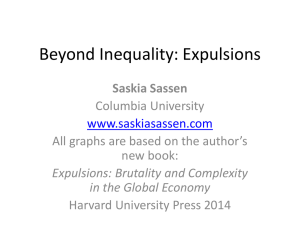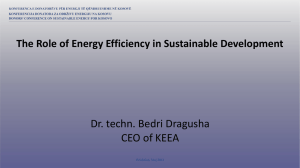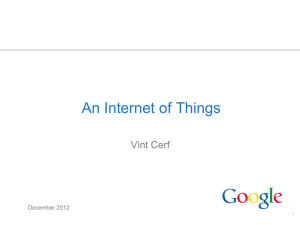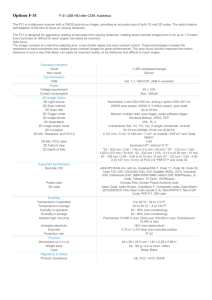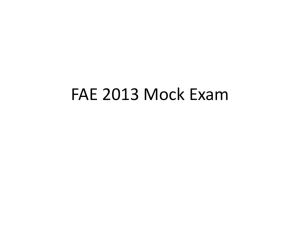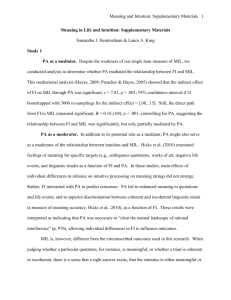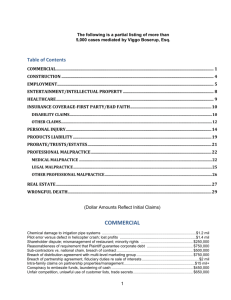Beyond Inequality: Expulsions
advertisement
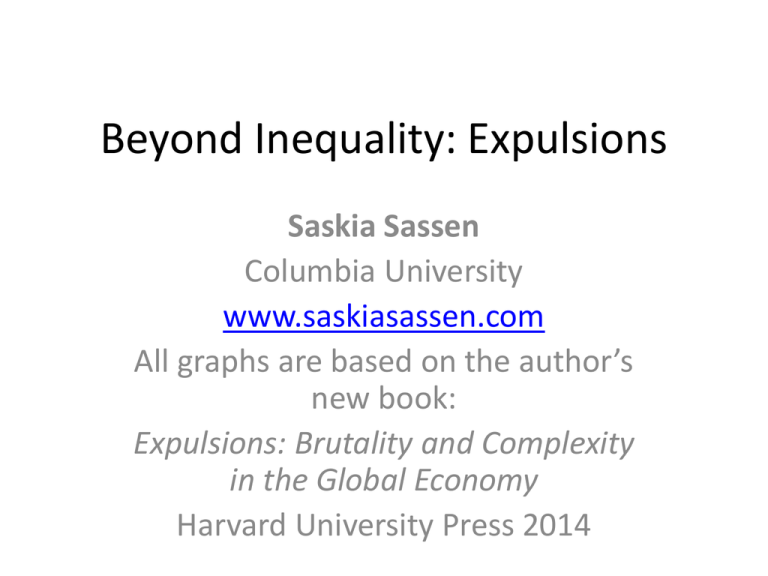
Beyond Inequality: Expulsions Saskia Sassen Columbia University www.saskiasassen.com All graphs are based on the author’s new book: Expulsions: Brutality and Complexity in the Global Economy Harvard University Press 2014 . • BEFORE METHOD: Analytic Tactics . Analytic Tactics Destabilizing stable meanings In the shadows of powerful explanations When territory exits conventional framings: it becomes institutionally mobile, nomadic and can alter the meaning of the “national” in its many diverse instantiations . . . Exhibit 2.1.c: Central Government Debt (% of GDP) in Fourteen Countries, 1980-2010 Year: Country: Australia Canada China Germany Greece Italy Japan Portugal Spain Sweden United States 1980 1990 2000 2010 8.0 26.1 1(a) 13.0 … 52.7 37.1 29.2 14.3 38.2 25.7 6.1 46.6 6.9 19.7 97.6(b) 92.8 47.0 51.7 36.5 39.6 41.5 11.4 40.9 16.4 38.4 108.9 103.6 106.1 52.1 49.9 56.9 33.9 11.0 36.1 33.5 44.4 147.8 109.0 183.5(d) 88.0 51.7 33.8 61.3 Source: OECD Stat Extracts and World Economic Outlook Database of the International Monetary Fund, accessed on January 3rd, 2013. Notes: (a) Data for 1984. (b) Data for 1993. (c) Data for 1991. (d) Data for 2009. . Exhibit 2.2.e: Ratio of 1% Wealth to Median Wealth, 1962-2010 Source: Economic Policy Institute (2013) “The ratio of average top 1% wealth to median wealth, 1962-2010”, The State of Working America, doi: http://stateofworkingamerica.org/data/, accessed on 9 February 2013. . Exhibit 2.2.f: Share of Total Wealth Gain,1983-2010 Source: Economic Policy Institute (2013) “Share of total wealth growth accruing to various wealth groups, 1983-2010”, The State of Working America, doi: http://stateofworkingamerica.org/data/, accessed on 9 February 2013. . Exhibit 2.4.a. Internally Displaced People, 2003-2012 Source: UNHCR Global Trends (2012) Displacement: The New 21st Century Challenge - Annexes. Table 23: Refugees, asylum-seekers, internally displaced persons (IDPs), returnees, stateless persons, and others of concerns to UNHCR by region, 2003-12, accessed on June 21 2013: http://www.unhcr.org/pages/49c3646c4d6.html Vulture Funds: one extreme case of aggressive innovation • Investing (profiting) off bankruptcies. • Corporate bankruptcies: ok, though can be destructive • Sovereign bankruptcies: a very different matter. An innovation in the context of intl system: typically end in lawsuits litigated in US courts. (They buy debt under explicit contract stipulations that differ greatly from govt and bank handling of sovereign debt).(Goes against Principles of International Comity that have and still rule the intl. system. Continuing… • In Oct 95, a NY vulture fund (Elliott and Assoc) bought $28.7 mil of Panama debt for 17.5$ mil. In July 96 it brought suit in a US court against Panam govt for full payment of debt plus interest. Got the court to approve and force P govt to pay 57 $ mil. • Same fund, same story, other govt: in March 96 bought 20.7$ mil in Peru govt debt from intl. banks for 11.4$ mil with a contract under NY law. In Oct 96 filed in NY State Supr Crt for 35 mil incl inrterests: 58 mil$ • In 1998 alone, Elliott went ag Ecuador, Ivory C,Poland, Congo. It collected 100 mil$ through its Ecaud and Vietnam suits. And prevented through legal injuctions, creditors in Canada, Neth, Germany, Luxemb, and Belgium from collecting before they did. . – WHAT IS THE STEAM ENGINE OF OUR EPOCH 13 When modest neighborhoods become part of global finance • 1. They key is that the source of profits for financial firms of sub-prime and other mortgages for low- and modest-income households is NOT payment on the mortgage. • 2. The source of profits is the bundling of a large number of these mortgages to sell them on to investors, including banks and foreign investors. It worked because they were mixed up with high quality debts of all sorts. Expulsions: Foreclosures • 2006 : 1.2 million foreclosures, up 42% from 2005. This is: One in every 92 U.S. households • 2007: 2.2 million forecls, up 75% from 06 • 2008: 3.1 million, up 81% from 07 • 2009: 3.9 million (or 1 in 45 US hholds) • (From 2007 to 2009: 120% increase in forecls) • 2010: 2.9 mill forecls. (2006-2010: over 13 mil) • Source: RealtyTrac 2007, 2008, 2009, 2010; Blomquist 2011 Table 8: Ratio of Household Credit to Personal Disposable Income (2000-05) 2000 2001 2002 2003 2004 2005 Emerging Markets Czech Republic 8.5 10.1 12.9 16.4 21.3 27.1 Hungary 11.2 14.4 20.9 29.5 33.9 39.3 Poland 10.1 10.3 10.9 12.6 14.5 18.2 India 4.7 5.4 6.4 7.4 9.7 … Korea 33.0 43.9 57.3 62.6 64.5 68.9 Philippines 1.7 4.6 5.5 5.5 5.6 … Taiwan 75.1 72.7 76.0 83.0 95.5 … Thailand 26.0 25.6 28.6 34.3 36.4 … Australia 83.3 86.7 95.6 109.0 119.0 124.5 France 57.8 57.5 58.2 59.8 64.2 69.2 Germany 70.4 70.1 69.1 70.3 70.5 70.0 Italy 25.0 25.8 27.0 28.7 31.8 34.8 Japan 73.6 75.7 77.6 77.3 77.9 77.8 Spain 65.2 70.4 76.9 86.4 98.8 112.7 United States 104.0 105.1 110.8 118.2 126.0 132.7 Mature Markets Source: IMF Staff estimates based on data from country authoriies, CEIC, OECD, and Bloomberg Table 11: Share of Foreign-Currency-Denominated Household Credit, End-2005 (In percent of total household credit) Source: IMF 2006. “Global Financial Stability Report: Market Developments and Issues.” IMF: World Economic and Financial Surveys. September, 2006. Retrieved August 26, 2008. [http://www.imf.org/external/pubs/ft/GFSR/2006/02/pdf/chap2.pdf] p. 54 Super-Prime Housing Market • Monaco 18.9 million $ Russian, CIS, UK, Italian, Scandinavian, Swiss • London 15.9 million$ Russian, French, South African, Italian, Indian, UAE, Greek, Australian, US, Canadian • New York City 10 million$ UK, French, Italian, Spanish, Mainland Chinese, Singaporean, Australian, Brazilian, Argentine, Canadian more • Dubai $8.0m African (Kenyan, Somali, Tanzanian), Saudi Arabian, Russian, Indian, Iranian -Paris 8.8 million$ Russian, CIS, Middle Eastern, Italian, French, Benelux, German, UK, US • Moscow $7.8m CIS More -Singapore 8.3 m$ Indonesian, Mainland Chinese, Malaysian, Indian, Australian, UK -Shanghai 6.4 million $ Hong Kong,Taiwanese, US, Canadian, Korean, Singaporean, Australian, Japanese, Malaysian, German, French - Hong Kong 15.4 m$ Mainland Chinese In the shadows of “urbanization” • . One instance From 2006 to 2010: 220 million hectares of land in Afri ,LatAm, Cambodia, Ukraine bought/leased by rich govts,firms,financial firms • The land is now more valued than the people or activities on it • The active making of surplus populations • Novel assemblage of Territory/Authority/Rights UNSTABLE MEANINGS • Membership in a nation-state Map of government and private security agencies in the US Source: Washington Post. 2010. “Top Secret America,” Interactive Maps. Washington Post, July 2010. http://projects.washingtonpost.com/top-secret-america/map/ More buildings • In Washington and the surrounding area, 33 building complexes for top-secret intelligence work are under construction or have been built since September 2001. • –Together they occupy about 17 million square feet – the equivalent of almost three Pentagons or 22 US Capitol buildings. The Global Street • A space for making by those who lack access to formal instruments for making. -making presence/estamos presentes -no explicit (conventional, standard) objective Urban capabilities –arising out of a mix of people and space Does the City Have Speech
